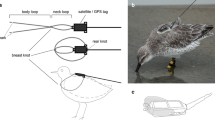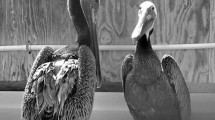Abstract
Satellite transmitters and other tracking devices are valuable tools for furthering our understanding of bird movements, and their use has been steadily increasing. Since the necessary handling of birds to deploy transmitters can have deleterious consequences and the transmitter itself can add substantial mass, particularly to small species, or bring discomfort to the individual birds to which they are attached, it is important to quantify the effect such devices on both the behavior and the fitness of equipped animals. Very few studies have focused on the demographic effects of equipping birds with a satellite transmitter, with the vast majority of such studies focusing on short-term behavioral effects. We have assessed the demographic effects of attaching a satellite transmitter to the back of adult breeding Wandering Albatross individuals using long-term demographic data (20 years) and recent developments in capture–recapture methodology. We found no evidence of any negative effects of the attached devices on the probability of survival, breeding, or breeding successfully in the current or following season in either males or females. We conclude that the current satellite transmitters and smaller devices used by researchers are valuable conservation and research tools that do not adversely affect the demographic traits of large albatrosses. Similar tests should be carried out on smaller species, which are more likely to be affected.
Zusammenfassung
Abschätzung des Effekts von Satellitensendern auf die Demographie des Wanderalbatrosses Diomedea exulans
Satellitensender und andere Routen-Kontrollgeräte sind wertvolle Hilfsmittel, um die Bewegungen von Vögeln zu verstehen, und werden zunehmend benutzt. Das Handling, das notwendig ist, um die Sender einzusetzen, kann jedoch schädliche Folgen haben, und die Sender können besonders bei kleinen Arten beträchtliches Gewicht hinzufügen oder für die Tiere, an denen sie befestigt werden, unangenehm sein. Daher ist es wichtig, ihren Effekt auf das Verhalten und insbesondere auf die Fitness der damit ausgestatteten Tiere zu quantifizieren. Nur sehr wenige Studien haben sich auf die demographischen Effekte von Satellitensendern auf Vögel konzentriert, und die überwiegende Mehrheit hat lediglich kurzzeitige Verhaltenseffekte untersucht. Wir haben die demographischen Effekte von Satellitensendern, die auf dem Rücken adulter brütender Wanderalbatrosse angebracht waren, abgeschätzt, unter Verwendung demographischer Langzeitdaten (20 Jahre) und neuer Entwicklungen in der Fang-Wiederfang- Methodik. Wir haben keine Belege für negative Effekte von angebrachten Geräten auf die Wahrscheinlichkeit, zu überleben, zu brüten oder in der aktuellen oder in zukünftigen Saisons erfolgreich zu brüten, bei Männchen und Weibchen gefunden. Wir folgern, dass die derzeit von Forschern verwendeten Satellitensender und kleineren Geräte nützliche Schutz- und Forschungshilfsmittel sind, welche die demographischen Eigenschaften großer Albatrosse nicht nachteilig beeinflussen. Ähnliche Tests sollten für kleinere Arten durchgeführt werden, die mit größerer Wahrscheinlichkeit beeinträchtigt sind.

Similar content being viewed by others
References
Barbraud C, Weimerskirch H (2011) Estimating survival and reproduction in a quasi biennally breeding seabird with uncertain and unobservable states. J Ornithol. doi:10.1007/s10336-011-0686-1
Burger AE, Shaffer SA (2008) Application of tracking and data-logging technology in research and conservation of seabirds. Auk 125:253–264
Burnham KP, Anderson DR (2002) Model selection and multimodel inference: a practical information–theoretic approach. Springer, New York
Chastel O, Weimerskirch H, Jouventin P (1995) Influence of body condition on the reproductive decision and reproductive success in the Blue Petrel. Auk 112:964–972
Choquet R, Rouan L, Pradel R (2009a) Program E-SURGE: a software application for fitting multievent models. In: Thomson DL, Cooch EG, Conroy MJ (eds) Modeling demographic processes in marked populations. Springer, New York, pp 845–865
Choquet R, Lebreton JD, Gimenez O, Reboulet AM, Pradel R (2009b) U-CARE: utilities for performing goodness of fit tests and manipulating capture-recapture data. Ecography 32:1071–1074
Converse SJ, Kendall WL, Doherty PF Jr, Ryan PG, Johnson DH (2009) Multistate models for estimation of survival and reproduction in the grey-headed albatross (Thalassarche chrysostoma). Auk 126:77–88
Delord K, Besson D, Barbraud C, Weimerskirch H (2008) Population trends in a community of large Procellariiforms of Indian Ocean: potential effects of environment and fisheries interactions. Biol Conserv 141:1840–1856
Fujiwara M, Caswell H (2002) A general approach to temporary emigration in mark–recapture analysis. Ecology 83:3266–3275
Goodman D (1974) Natural selection and a cost ceiling on reproductive effort. Am Nat 108:247–268
Green JA, Tanton JL, Woakes AJ, Boyd IL, Butler PJ (2004) Effects of long-term implanted data loggers on macaroni penguins Eudyptes chrysolophus. J Avian Biol 35:370–376
Hamel NJ, Parrish JK, Conquest LL (2004) Effects of tagging on behaviour, provisioning, and reproduction in the Common Murre (Uria aalge), a diving seabird. Auk 121:1161–1171
Hines JE, Sauer JR (1989) Program CONTRAST—a general program for the analysis of several survival or recovery rate estimates. Fish Wildl Tech Rep 24:1–7
Hunter CM, Caswell H (2009) Rank and redundancy of multistate mark-recapture models for seabird populations with unobservable states. In: Thomson DL, Cooch EG, Conroy MJ (eds) Modeling demographic processes in marked populations. Springer, New York, pp 797–825
International Union for Conservation of Nature (IUCN) (2009) IUCN red list of threatened species. Available at: http://www.iucnredlist.org/
Jouventin P, Weimerskirch H (1990) Satellite tracking of Wandering albatrosses. Nature 343:746–748
Kendall WL, Bjorkland R (2001) Using open robust design models to estimate temporary emigration from capture–recapture data. Biometrics 57:1113–1122
Kendall WL, Nichols JD (2002) Estimating state-transition probabilities for unobservable states using capture–recapture/resighting data. Ecology 83:3276–3284
McMahon CR, Field IC, Bradshaw CJA, White GC, Hindell MA (2008) Tracking and data-logging devices attached to elephant seals do not affect individual mass gain or survival. J Exp Mar Biol Ecol 360:71–77
Paredes R, Jones IL, Boness DJ (2005) Reduced parental care, compensatory behaviour and reproductive costs of thick-billed Murres equipped with data loggers. Anim Behav 69:197–208
Passos C, Navarro J, Giudici A, Gonzáles-Solís J (2010) Effects of extra mass on the pelagic behavior of a seabird. Auk 127:100–107
Phillips RA, Xavier JC, Croxall JP (2003) Effects of satellite transmitters on albatrosses and petrels. Auk 120:1082–1090
Pradel R (2005) Multievent: an extension of multistate capture-recapture models to uncertain states. Biometrics 61:442–447
Pradel R, Wintrebert CMA, Gimenez O (2003) A proposal for a goodness of fit test to the Arnason-Schwarz multisite capture-recapture model. Biometrics 59:43–53
R Development Core Team (2009) R: a language and environment for statistical computing. R Foundation for Statistical Computing, Vienna, Austria. Available at: http://www.R-project.org
Rivalan P, Prévot-Juillard AC, Choquet R, Pradel R, Jacquemin B, Girondot M (2005) Trade-off between current reproductive effort and delay to next reproduction in the leatherback sea turtle. Oecologia 145:564–574
Robert M, Drolet B, Savard JP (2006) Effects of backpack radio-transmitters on females Barrow’s Goldeneyes. Waterbirds 29:115–120
Schaub M, Gimenez O, Schmidt BR, Pradel R (2004) Estimating survival and temporary emigration in the multistate capture-recapture framework. Ecology 85:2107–2113
Viallefont A, Cooke F, Lebreton JD (1995) Age-specific cost of first-time breeding. Auk 112:67–76
Weimerskirch H (2007) Are seabirds foraging for unpredictable resources? Deep Sea Res II 54:211–223
Weimerskirch H, Jouventin P (1987) Population dynamics of the Wandering Albatross (Diomedea exulans) of the Crozet Islands: causes and consequences of the population decline. Oikos 49:315–322
Weimerskirch H, Salamolard M, Jouventin P (1992) Satellite telemetry of foraging movements in the Wandering Albatross. In: Priede IG, Swift SM (eds) Wildlife telemetry—remote monitoring and tracking of animals. Ellis Horwood, Chichester, pp 185–188
Weimerskirch H, Doncaster CP, Cuenot-Chaillet F (1994) Pelagic seabirds and the marine environment: foraging of wandering albatrosses in relation to the availability and distribution of their prey. Proc Roy Soc Lond B 255:91–97
Weimerskirch H, Lallemand J, Martin J (2005) Population sex ratio variation in a monogamous long-lived bird, the Wandering Albatross. J Anim Ecol 74:285–291
Williams GC (1966) Adaptation and natural selection. Princeton University Press, Princeton
Acknowledgments
The present research project No. 109 was performed on Possession Island, Crozet Island and was supported by the French Polar Institute (IPEV) and Terres Australes et Antarctiques Françaises. We thank all of the field workers involved in the demographic study on Possession Island and Dominique Besson and Karine Delord for data managing. The methods described (modeling survival in biennial species) were used following those developed by the Woods Hole Oceanographic Institution Albatross Demography Workshops, funded by NSF Grant DEB-0343820 and led by Hal Caswell and Christine Hunter.
Author information
Authors and Affiliations
Corresponding author
Additional information
Communicated by P. H. Becker.
Rights and permissions
About this article
Cite this article
Barbraud, C., Weimerskirch, H. Assessing the effect of satellite transmitters on the demography of the Wandering Albatross Diomedea exulans . J Ornithol 153, 375–383 (2012). https://doi.org/10.1007/s10336-011-0752-8
Received:
Revised:
Accepted:
Published:
Issue Date:
DOI: https://doi.org/10.1007/s10336-011-0752-8




